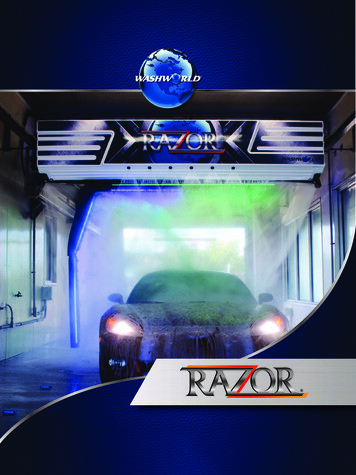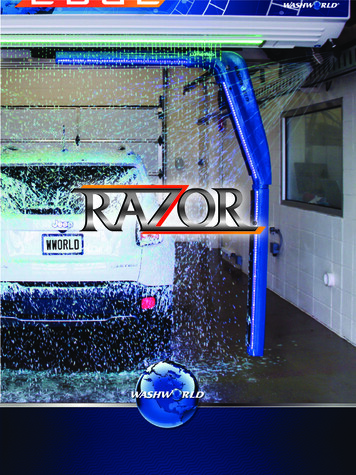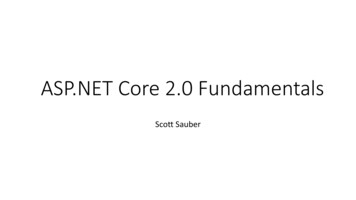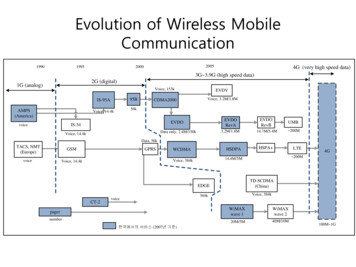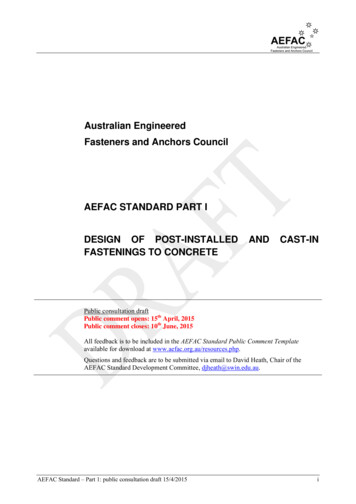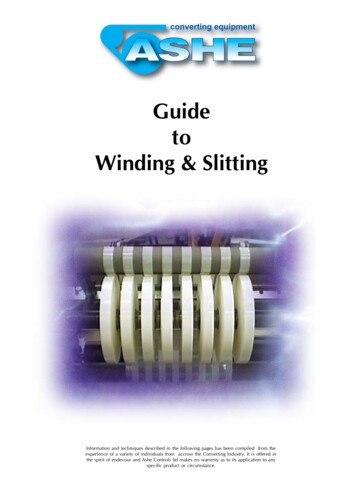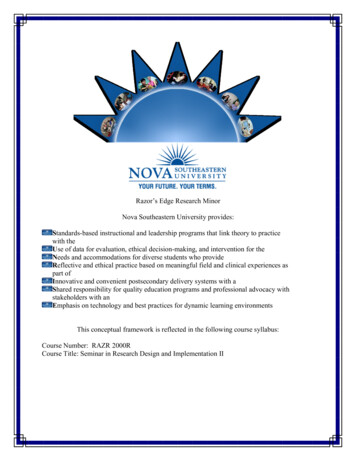
Transcription
Razor’s Edge Research MinorNova Southeastern University provides:Standards-based instructional and leadership programs that link theory to practicewith theUse of data for evaluation, ethical decision-making, and intervention for theNeeds and accommodations for diverse students who provideReflective and ethical practice based on meaningful field and clinical experiences aspart ofInnovative and convenient postsecondary delivery systems with aShared responsibility for quality education programs and professional advocacy withstakeholders with anEmphasis on technology and best practices for dynamic learning environmentsThis conceptual framework is reflected in the following course syllabus:Course Number: RAZR 2000RCourse Title: Seminar in Research Design and Implementation II
Nova Southeastern UniversityAbraham S. Fischler College of EducationRAZR 2000R SyllabusI. COURSE NUMBER AND TITLE: RAZR 2000R Seminar in Research Design andImplementation II (3 credits)II. INSTRUCTOR FOR THIS COURSEName: Steven A Hecht, Ph.D.Email address: shecht@nova.eduTelephone: 954-262-8468Text: 561-271-8113Office: Campus Support Building, 7500 SW 36th Street, Room 152KName: Dana S. Mills, Ph.D.Email address: dmills@nova.eduTelephone: 954-262-7818Text: 954-258-6365Office: Campus Support Building, 7500 SW 36th Street, Room 152FNSU students should contact their on-site instructor for any questions regarding thiscourse.PROFESSOR RESPONSIBLE FOR SYLLABUSName: Steven A Hecht, Ph.D.Email address: shecht@nova.eduTelephone: 561-271-8113Office: Campus Support Building, 7500 SW 36th Street, Room 152KInstructors are invited to contact the professor above for questions about this syllabus.NOTE: To ensure program consistency, all sections of each course in the Abraham S. FischlerCollege of Education, regardless of delivery format, follow the same course requirements aslisted in this syllabus that is provided by the responsible professor. Instructors may modifyreadings, topics, or assignments in consultation with the responsible professor listed above.To that end, the course will employ guided discussions during weekly meetings focusing onpublished peer reviewed studies. Class presentations will be delivered by teams of selectedstudents focused on demonstrating a clear understanding of the research design and resultsfrom published, timely and relevant articles within a chosen field of study. Students willcomplete all aspects of the University-based project that commenced in RAZR1000R asfollows: formulating research questions and hypotheses, designing a brief instrument,collecting data within the university, analyzing the data, and presenting findings to the class.III. COURSE DESCRIPTIONRAZR2000RPage 1 of 213/16/2015
Students will continue to explore how basic scientific paradigms are used to both understandpublished research and plan new investigations. This seminar course will involve guidedclass discussions focusing on both published peer reviewed studies and conducting anoriginal University-based project. Class presentations will be delivered by teams of studentsand will focus on the role of theory in development of research questions and hypotheses,research design, and interpretation of results from peer-reviewed research articles within achosen field of study. Students will complete all aspects of the University-based project thatwas started in RAZR1000R as follows: formulating a research question, designing a briefinstrument, collecting data within the University, analyzing the data, formally writing-upresults, and presenting findings to the class. Prerequisites: Students must pass RAZR1000Rwith a B letter grade or better. Frequency: Every WinterCourse Rationale: This seminar course is part of a two-part series of courses designed toprovide Razor’s Edge Research Scholarship Program participants with exposure to theresearch process through a) evaluation of published research studies, and b) conducting aUniversity-based research project. Participation in this course will provide the followingcompetencies and experiences: Knowledge about research from various disciplinesAcquisition of a deeper understanding of published research through classpresentations that both describe and evaluation prior work.Understanding of the importance of the application of science-based principleswithin each student’s area of studyHands-on research experience by conducting an authentic University-basedresearch project.Description and justification of one’s own research by presenting a Universitybased research project.IV. COURSE LEARNING OUTCOMES AND OBJECTIVESA. LEARNING OUTCOMESUpon completion of this class, students will:1) Demonstrate understanding of published research by summarization andevaluation of same to a peer audience via class presentation.2) Implement a unique University-based research project.3) Conduct basic descriptive and inferential statistical analyses using SPSS toanswer research questions4) Describe and defend original research to peersB. OBJECTIVES FOR THE COURSE1.0 To develop students’ research-related skills1.1 Students will use technology to communicate research in class.1.2 Students will identify and communicate the significance, purpose, methods, mainresults, and conclusions from published research.1.3 Students will critically reflect upon scientific knowledge and discoveries inrelation to quality of the evidence.RAZR2000RPage 2 of 211/9/2017
1.4 Students will compose and submit appropriate forms for approval of collection ofdata from human subjects (Institutional Review Board and university wide SurveyResearch Committee).2.0 To guide and mentor students in developing, completing, writing-up, and presenting avalid and ethical scientific study.2.1 Students will learn basic descriptive and inferential statistics.2.2 Students will enter data into IBM SPSS and carry-out statistics to answer researchquestions by completing a IBM SPSS Data Analysis Project.2.3 Students will complete a University-based research project that includes thefollowing elements: formulating a research question, designing a brief instrument,collecting data within the university, analyzing the data using SPSS, writing-up aresearch report2.4 Students will both summarize and justify conclusions obtained from theirUniversity-based research project to the class via a technology enhanced classpresentation.V. REQUIRED MATERIALSA. Required Printed Textbook(s):*Creswell, J. W. (2015). Educational research: Planning, conducting, and evaluatingquantitative and qualitative research (5th ed.). Upper Saddle River, NJ: Pearson.Edmonds, W. A., & Kennedy, T. D. (2012). An applied reference guide to researchdesigns: Quantitative, Qualitative, and Mixed Methods. Thousand Oaks, CA: Sage* This text was also required for RAZR1000R.B. Required Supplemental Materials:American Psychological Association. (2010). Publication manual of the AmericanPsychological Association (6th ed.). Washington, DC: Author.Peer reviewed journal articles which will be provided to you in electronic form.C. Required Technology: Each NSU student must acquire a working NSU email address forenrollment in all courses, whether instruction is live or online. To open an NSU email, go tohttp://www.nova.edu/resources/nsuidentity.html. Students will need a computer for onlinechats via Go To Training. Students will need to obtain a rental version of SPSS.VI. CALENDAR OF WEEKLY REQUIREMENTSA. General InformationThe primary methods of instruction used in this course are presentation, in-class discussions,and hands-on research experience. Students will individually present via PowerPoint a publishedpeer reviewed research study focusing on a topic in their area of interest. The research articlewill be located by the student and approved by the course instructor no later than Thursday,February 2 by 11:59pm. Student must have research article approved by this date inorder to obtain course credit for this presentation.RAZR2000RPage 3 of 211/9/2017
Each student will conduct their own University-based research project that was approved andpresented in RAZR1000R. Review the syllabus carefully and have available in class in paper orelectronic form. Student must present the University-based research project to the class on thedate that student is scheduled to present in order to obtain course credit for this presentation.B. Legend for CalendarDate/Topics/ Readings/Classroom ew Syllabus, Including Overview of Structure of the Course, BasicWeek 1Introduction to IBM SPSS, The parts of a University Based Research proposal.1/10 & 1/12Readings: Please bring a hard copy of your IRB application for yourUniversity Based Research Project.Classroom activity: Lecture and group discussionGroup Assignment: Start work on your Group Project 1 (First draft of yourUniversity based research proposal).Week 2Topic: IRB Manager Tutorial, Basic Introduction to IBM SPSS1/17 & 1/19Readings: Yockey (2011). SPSS Demystified: A step-by-step guide to successfuldata analysis.Classroom activity: Professor led discussion of IBM SPSS data entry and basicdescriptive statistics (mean, median, mode, standard deviation, range).Assignment: NoneWeek 31/24 & 1/26Topic: Basic Introduction to IBM SPSS; Basic Quantitative Designs: BetweenSubjectsReadings: Edmonds & Kennedy (2013), pages 19-38Classroom activity: Professor led discussionAssignment: Individual Assignment: Project 2 (IBM SPSS statistical analysisproject).Group Project 1 (First draft of your University based research proposal) dueThursday, January 26.RAZR2000RPage 4 of 211/9/2017
Date/CourseObjectiveWeek 4Topics/ Readings/Classroom activity/Assignments/Blackboard1/31 & 2/2Readings: Edmonds & Kennedy (2013), pages 44-57Topic: Basic Quantitative Designs: Within-SubjectsClassroom activity: Professor led discussionGroup Assignment: Project 3 (Final draft of your University Based ResearchProject research proposal) AND IRB submission due February 2.Submit copy of your article for the individual discussion board presentationof published research assignment to Dr. Hecht for approval by February 2.Week 5Topic: Basic Quantitative Designs: Factorial Designs2/7 & 2/9Readings: Edmonds & Kennedy (2013), pages 58-73Classroom activity: Professor led discussionIndividual Assignment: Project 2 (IBM SPSS statistical analysis project) dueFebruary 9th.Week 6Topic: Basic Quantitative Designs: Solomon N-Group Designs, Single-Case2/14 & 2/16Readings: Edmonds & Kennedy (2013), 74-94Classroom activity: Professor led discussionAssignment: NoneWeek 72/21 & 2/23Topic: Basic Quantitative Designs: Ex Post Facto, Posstest-Only, Observational,Survey ApproachesReadings: Edmonds & Kennedy (2013), 95-110Classroom activity: Professor led discussionAssignment: NoneguidanceRAZR2000RPage 5 of 211/9/2017
Date/ CourseObjectiveWeek 8Topics/ Readings/Classroom activity/Assignments/Blackboard2/28 & 3/2Readings: Creswell, 2015, Chapter 7 Collecting Qualitative DataTopic: Collecting and Analyzing Qualitative DataClassroom activity: Professor led discussionWeek 9Assignment: Individual Assignment: Project 4 (Qualitative analysis project).Spring Break – No Class3/7 & 3/9Week 10Topic: Basic Qualitative Designs: Grounded Theory Approach3/14 & 3/16Readings: Edmonds & Kennedy (2013): pages 111-121Classroom activity: Professor led discussionIndividual Assignment: None.Project 5 (Individual discussion presentation) due March 16.Week 11Topic: Basic Qualitative Designs: Ethnographic Approach3/21 & 3/23Readings: Edmonds & Kennedy (2013): pages 122-128Classroom activity: Professor led discussionWeek 123/28 & 3/30Individual Assignment: None.Topic: Basic Qualitative Designs: Narrative, PhenomenologicalReadings: Edmonds & Kennedy (2013): pages 129-144Classroom activity: Professor led discussionIndividual Assignment: Project 4 (Qualitative analysis project)RAZR2000RPage 6 of 211/9/2017
Date/ CourseObjectiveTopics/ Readings/Classroom activity/Assignments/BlackboardWeek 13Topic: Undergraduate Student Symposium – Friday, April 7th. html .4/4 & 4/6Readings: Posters at the Undergraduate Student Symposium on Friday, 4/6Classroom activity: Professor led discussion on 4/4 and No Class 4/6Week 144/11 & 4/13Individual Assignment: Project 6 (Undergraduate Student Symposium ReactionPaper).Group Assignment: Project 7 (Group PowerPoint presentation that includes theresults from your University Based Research Project).Topics: Impressions from the Undergraduate Student Symposium; MixedMethods ApproachReadings: Edmonds & Kennedy (2013): pages 145-181Classroom activity: Professor led discussionWeek 154/18 & 4/20Project 4 (Qualitative analysis project) due April 13Project 6 (Undergraduate Student Symposium Reaction Paper) due April 13Topic: Group presentation and discussion of University Based Research ProjectResultsReadings: TBDClassroom activity: Student-led technology-assisted presentations and groupdiscussionGroup Assignment: Project 7 (Prepare your group PowerPoint presentationthat includes the results from your University Based Research Project) duethis week.Project 8: Critiques of peers’ individual discussion board presentations dueApril 20.RAZR2000RPage 7 of 211/9/2017
Date/ CourseObjectiveTopics/ Readings/Classroom activity/Assignments/BlackboardWeek 16Topic: Group presentation and discussion of University Based Research ProjectResults4/25 & 4/27Readings: TBDClassroom activity: Student-led technology-assisted presentations and groupdiscussionGroup Assignment: Project 7 (Prepare your group PowerPoint presentationthat includes the results from your University Based Research Project) duethis week.VII. DESCRIPTION OF ASSIGNMENTS AND THEIR RUBRICSUnderstanding research involves both careful study and communication with peers. Participantswill be expected to engage in the material, complete assigned research articles, and be activelyengaged during class. The grade for this course will be based upon the following:Class Attendance and Participation: Students will be expected to attend class regularly and beactively engaged in discussion with peers during in-classroom presentations of publishedresearch. In the event of nonattendance, points will be awarded at the discretion of instructorbased on reason for nonattendance.Attendance and Participation –(6 pt. per week X 16 weeks 96 pts Total)Rubric:ExpectationsTimely Attendance1 point per classpossibleNot Met (0 points)Did not attend classsession or did notattend class sessionon time.Met (1-2 points)Active Participation3 points per classpossibleChose not toparticipate indiscussions and inclass activitiesSome participation inclass discussions and inclass activitiesRAZR2000RPage 8 of 21Exceeds (3 points)Attended classsession on timeEngagedparticipation inclass activities,asked questions,significantcontribution todiscussion1/9/2017
Project 1: First draft of University based research proposal: Students will produce aresearch proposal that includes final details concerning all procedures and instruments that willbe employed to carry out the University Based Research Study. This proposal will be writtenwith the goal in mind to have sufficient development of the project so that you can a) submityour Institutional Review Board submission, and b) conduct your study. Proof of purchase anduse of specialized software (e.g., pulse monitor in the case of studying heart rate during sleep)will need to be documented as well. Students will be provided a Project 1 Guidance Documentwhich will describe the specific elements to include in this research rpose of theStudyReview h DesignRAZR2000RInsufficient(0 to 1 points)Adequate(2-3 points)Excellent(4-5 points) The statement of theresearch problem isincomplete and/or unfocused. The statement of theproblem is not interesting,nor engaging. Identifies the researchproblem. Effectively demonstratesthe importance of the topic. Clearly and conciselyidentifies the researchproblem in a single sentence Effectively demonstrates theimportance of the problem. The statement of theproblem is engaging, andthought provoking.The purpose of the study isincomplete or missing.Clearly states the purpose ofthe study.Clearly and concisely statesthe purpose of the study. Reviewed literature is notrelevant to the study. Reviews relevantliterature. Establishes how researchfits with existing work. Presents a logicalargument of the importanceof the study. The literature review ispresented in a fluid andcoherent manner. Reviews relevant literature. Establishes how research fitswith existing work. Presents a logical argumentof the importance of the study. The literature review ispresented in a fluid andcoherent manner. Critical analysis of relevantliterature. Research questions arelacking or do not adequatelyaddress the purpose of thestudy. Research hypotheses aremissing or do not adequatelyanswer the researchquestions. At least one researchquestion is stated to addressthe purpose of the study. Most of the researchhypotheses are written toadequately answer theresearch questions. All obvious researchquestions are stated to addressthe purpose of the study. Research hypotheses arewritten, as expected, toadequately answer theresearch questions.Missing or very sparsedescription of the plan to beused to investigate theresearch questions.Description of the plan to beused to investigate theresearch questions. Aminimal number of elementsor steps are missing in theplan.Thorough and accuratedescription of the plan to beused to investigate theresearch questions.Page 9 of 211/9/2017
ItemInsufficient(0 to 1 points)Adequate(2-3 points)Data SourcesParticipants Provides no detail about theparticipants to identify thepopulation from which thesample of participants isdrawn. Provides some detail aboutthe participants to identifythe population from whichthe sample of participants isdrawn. Provides sufficient detailabout the participants toidentify the population fromwhich the sample ofparticipants is drawn.Sampling ProceduresIncomplete description of theprocedures used forsampling.Provides a partialdescription of theprocedures used forsampling. It is unclearwhether or not the stateddescription will provide asufficient number ofparticipants.Provides a complete and fulldescription of the proceduresused for obtaining the sample.It is clear that the stateddescription provides aplausible strategy forobtaining s sufficient numberof participants.Data CollectionStrategies Incomplete description ofthe strategies that will beused to collect the data. There is no justification forthe selection of theinstruments. Provides no information onthe reliability and validity ofany published measurementinstruments. Provides a partialdescription of the strategiesthat will be used to collectthe data. Provides some justificationfor the selection of thestrategies for data collection. Provides partialinformation about thereliability and validity ofany published measurementinstruments. If a new instrument will becreated, insufficientdocumentation concerninghow reliability/validity ofthe instrument will beexamined. Provides a complete and fulldescription of the strategiesthat will be used to collect thedata. Justifies the selection of thestrategies. Provides reliability andvalidity of any publishedmeasurement instruments. If a new instrument will becreated, sufficientdocumentation providedconcerning howreliability/validity of theinstrument will be examined.Analyses of Data There is no description ofthe plan for data analysis. The data analyses plans donot adequately match theresearch questions Partially describes theanalysis of the data to testthe stated hypotheses or toanswer the stated researchquestions. Describes thoroughly theanalysis of the data to test thestated hypotheses or to answerthe stated research questions.(Note: it is not necessary tostate the appropriate statisticaltest at this point).Plan to MinimizePotential Issues Relatedto Data Quality andInference QualityAdheres to APA format;coherent; grammaticallycorrect There is no description ofthe procedures for ensuringdata quality. Describes some of theprocedures for ensuring dataquality, but some obviousstrategies are left out. Describes thoroughly theprocedures for ensuring dataquality. Multiple errors in APAformat. Awkward constructionand/or poor flow of ideas. Grammatically incorrect. Some APA errors. Writing shows evidence ofself-editing with someconstruction and/or flowproblems. Some grammatical errorsRAZR2000RExcellent(4-5 points).Page 10 of 21 Accurate use of APA formatwith minimal errors. Coherent development of theideas using well-formedsentences and flowingparagraphs. Grammatically correct.1/9/2017
Project 2: IBM SPSS statistical analysis project: Students will analyze mock quantitative datausing IBM SPSS statistical software. Directions for this assignment will be provided ina Project 2 Guidance Document. Students will paste relevant SPSS output into a MSWorddocument and also provide narrative concerning interpretation of statistical results in the sameMSWord document.Rubric:ItemInsufficient(0 to 1 points)Adequate(2-3 points)Excellent(4-5 points)Content KnowledgeShows some understandingof the content knowledgecovered by the assignment, butdoes not include most of theelements required to completethe project.Shows good understandingof the content knowledgecovered by the assignment,and includes some but notmost of the elementsrequired to complete theproject.Shows excellentunderstandingof the content knowledgecovered by the assignment,and includes most of theelements required tocomplete the project.Critical ThinkingShows minimal creativethinking or generalization ofcontent covered in class to anew assessment contextDemonstrates substantialcreative thinking andgeneralization of contentcovered in class to newassessment context.CommunicationMost inferential or descriptivestatistical results are notreported or reported with majorerrors in APA format;Severe problems with sentencecoherence & grammar.Interpretation of IBMSPSS Outputs (5 pointsmax)Results from IBM SPSS output are not interpreted at allor misinterpreted;Interpretation of findings notprovided in completesentences;Demonstrates somecreativethinking but limitedgeneralization of contentcovered in class to newassessment context. Toomuch reiteration ofassessment content coveredin class.Some inferential ordescriptive statisticalresults reported with errorsin APA format;Moderate problems withcoherence of sentences andgrammar.Most of the results fromIBM SPSS output areinterpreted correctly;Only minor errors in APAformat;Minor problems withcoherence of sentences orgrammar.Consistently correctinterpretation of results fromIBM SPSS output;Project 3: Final draft of University based research proposal: Students will produce aFINAL version of the University based research proposal. This final version will incorporate allfeedback that was provided for Project 1. In addition, students will complete preparation of allaspects of the Institutional Review Board application via IRBManager, including consent formsand uploading of all research protocols.RAZR2000RPage 11 of 211/9/2017
Rubric:ExpectationsResponsiveness toFeedback from the priorProject 1SubmissionIRB Submission viaIRBManagerNot Met (0 points)Student did notadequately respondto most of thefeedback providedfrom the priorProject 1.Student did notsubmit protocolthrough theIRBManager, ormost entries inIRBManager wereincorrect or poorlywritten.Met (1 to 2 points)Student adequatelyresponded to most of thefeedback provided fromthe prior Project 1.Most of the entriessubmitted viaIRBManager were donecorrectly and writtenwell; protocol is almostready to submit to theIRB office, one or moredocuments were notcreated properly or werenot uploaded (e.g.,informed consent form,instruments).Exceeds (3points)Studentadequatelyresponded to allof the feedbackprovided from theprior Project 1.Protocol is readyto submit to theIRB office withonly minorediting or noediting required.Project 4: Qualitative data analysis project: Students will analyze mock qualitative datausing appropriate procedures. Directions for this assignment will be provided in a Project 4Guidance Document.Rubric:ItemInsufficient(0 to 1 points)Adequate(2-3 points)Content KnowledgeShows some understandingof the content knowledgecovered by the assignment, butdoes not include most of theelements required to completethe project.Shows good understandingof the content knowledgecovered by the assignment,and includes some but notmost of the elementsrequired to complete theproject.Shows excellentunderstandingof the content knowledgecovered by the assignment,and includes most of theelements required tocomplete the project.Critical ThinkingShows minimal creativethinking or generalization ofcontent covered in class to anew assessment contextDemonstrates somecreativethinking but limitedgeneralization of contentcovered in class to newassessment context. Toomuch reiteration ofassessment content coveredin class.Demonstrates substantialcreative thinking andgeneralization of contentcovered in class to newassessment context.RAZR2000RPage 12 of 21Excellent(4-5 points)1/9/2017
ItemInsufficient(0 to 1 points)Adequate(2-3 points)CommunicationMost qualitative results are notreported or reported with majorerrors in APA format;Severe problems with sentencecoherence & grammar.Appropriateness ofthematic analysisResults from thematic analysisare ambiguous or not plausible.Some qualitative resultsreported with errors inAPA format;Moderate problems withcoherence of sentences andgrammar.Most of the thematiccategories are plausible, butsome of the results areambiguous or not plausible.Excellent(4-5 points)Only minor errors in APAformat;Minor problems withcoherence of sentences orgrammar.All aspects of the thematicanalysis are plausible andwell-described.Project 5: Individual discussion board presentation of a research study pertaining toYOUR research interest: Each student will independently produce and deliver a technologyassisted presentation of a research article. The article must be published in a peer reviewedscientific journal. This is not a group project; as such, no two students can present the samearticle. The article must be approved by Dr. Steve Hecht by no later than Thursday, February 2by 11:59pm. Student must have research article approved by this date in order to obtain coursecredit for this presentation. The article should focus on an area of research that is within thescope of the student’s research interests. The presentation of this article will include essentialelements which will be described in a Project 5 Guidance Document. The student will presentthe article by posting a narrated PowerPoint or Prezi presentation in the discussion board. Pleasebe sure that the presentation is saved in a format that anyone can hear and see (for example, evensomeone who does not have Prezi installed on their computer). The presentation should bepresented in such a way that all audience members, including those without any background inthe research area, will understand the material and its contribution to scientific inquiry.Rubric:ExpectationsNot Met (0 points)PowerPointStudent did not presentPresentation PowerPoint presentation.Quality ofPowerPointPresentationRAZR2000RMet (1 to 2 points)Student presentedPowerPoint presentation;however, there were lessthan 10 slidesPowerPoint presentationPowerPoint presentationdoes not include oradequately describes atinadequately describesleast four of thesemore than one of thesesections: a) backgroundsections: a) backgroundand significance, b)and significance, b)methods, c) results, d)methods, c) results, d)conclusions, e) limitationsconclusions, e) limitations and future directions.and future directions.Page 13 of 21Exceeds (3 points)Student presentedPowerPointpresentation with over10 slides.PowerPointpresentation adequatelydescribes all of thesesections a) backgroundand significance, b)methods, c) results, d)conclusions, e)limitations and futuredirections.1/9/2017
Project 6: Undergraduate Student Symposium reaction paper: Students will attend theUndergraduate Student Symposium on Friday, April 6th. Students will be provided a Project 6Guidance Document that will describe the specific elements to include in a reaction paper.These tasks include: a) previewing and critiquing assigned posters, b) attending and critiquingassigned oral presentations, and c) summarize impressions from panel discussion with facultyreviewers prior to the USS event. This panel discussion will focus on the philosophy and historyof academic review.Rubric:ExpectationsArticle CritiqueOral PresentationCritiquePanel DiscussionSummaryNot Met (0 points)Met (1 to 2 points)Student did notcritique all assignedposters and/orcritiques werepoorly written orotherwise reflectedvery little effort.Student did notcritique all assignedoral presentationsand/or critiques werepoorly written orotherwise reflectedvery little effort.Student did notsubmit paneldiscussion summaryand/or summary waspoorly written orotherwise reflectedvery little effort.Student critiqued allassigned posters andmost critiques were wellwritten and showedconsiderable thought.Student critiqued allassigned oralpresentations and mostcritiques were wellwritten and showedconsiderable thought.Student’s paneldiscussion summary waswell-described but didnot include some obviousdiscussion points orwriting quality was poor.Exceeds (3points)Student’scritiques allassigned posters,and all critiqueswere well-writtenand thorough.Student’scritiques allassigned oralpresentations, andall critiques werewell-written andthorough.Student’s paneldiscussionsummary waswell-describedand thorough.Project 7: Presentation of results from your University Based Research Project: S
Razor’s Edge Research Minor Nova Southeastern University provides: Standards-based instructional and leadership programs that link theory to practice with the Use of data for evaluation, ethical decision-making, and intervention for the Needs and accommodations for diverse students who provide Reflec
